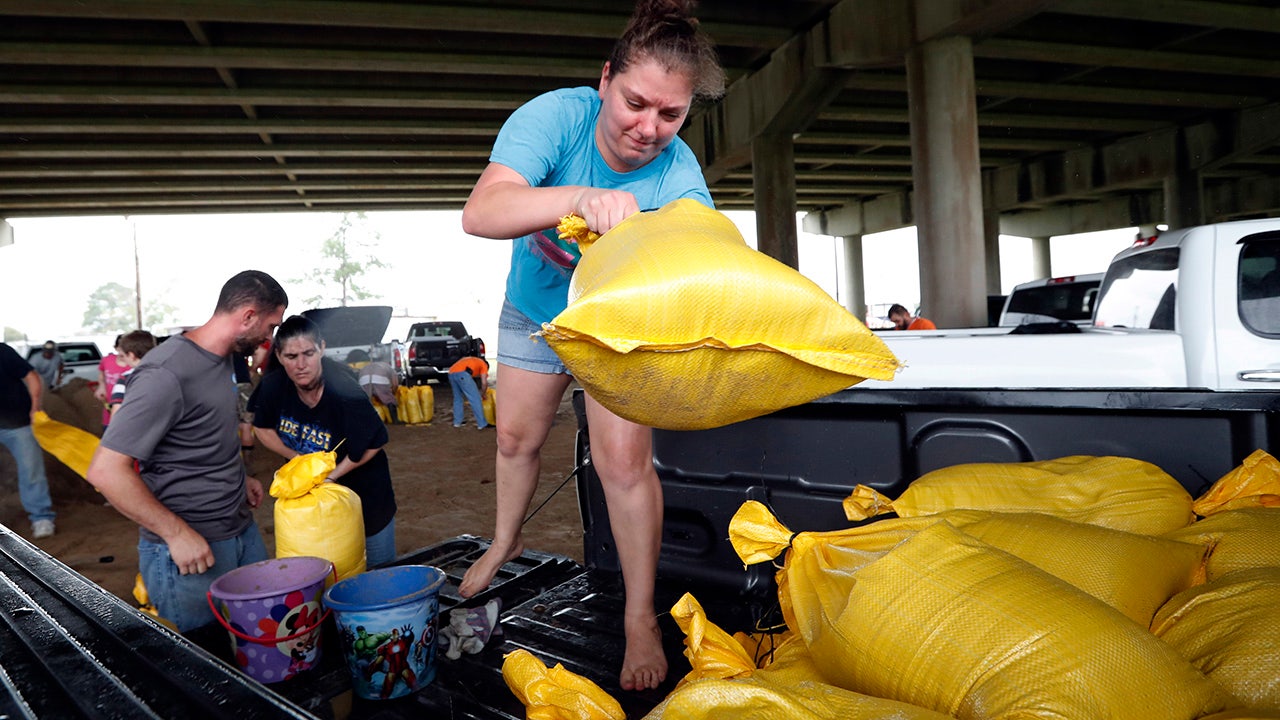
Tropical Storm Barry is “on the edge of hurricane status” as it inches closer to the Louisiana coast, bringing with it up to 20 inches of water when it makes landfall early Saturday morning.
The National Weather Service said in its 8 a.m. advisory on Saturday that the storm strengthened slightly, moving northwest at 5 miles per hour with maximum sustained winds of 70 mph.
“With the center just offshore and landfall within the next couple hours, Barry is right on the edge of the tropical storm-hurricane status,” Fox News meteorologist Brandon Noriega said. “This wind field will weaken quickly after landfall, keeping the biggest threat from Barry as water from rainfall, flooding, and surge near the coast.”
He said inland across the Mississippi River Valley, forecasters expect to see rain and flooding for some days after the storm. Isolated tornadoes are also possible across the region into Sunday.
Barry is expected to reach hurricane strength by the time its center reaches the Louisiana coast, expected before noon local time.
The storm was expected to inflict the most damage on Louisiana and parts of Mississippi, with wind and rain affecting more than 3 million people.
Some Louisiana parishes around Morgan City were reporting more than half their customers without electricity around daybreak Saturday.
COAST GUARD RESCUES 12 TRAPPED ON REMOTE LOUISIANA ISLAND
More than 50,000 people in southern Louisiana had lost power, and some roads were underwater as the edges of the storm-lashed Louisiana and coastal Mississippi and Alabama with rain.
In the coastal community of Isle de Jean Charles, the U.S. Coast Guard successfully rescued 12 people trapped after rising waters cut off access.
TROPICAL STORM BARRY PROMPTS STORM SURGE, FLOOD WARNINGS: WHY IS NEW ORLEANS AT AN INCREASED RISK?
On-again, off-again rain hit New Orleans overnight. As day broke, the streets in the normally raucous French Quarter tourist district were largely empty and barely damp. Dog walkers and a street sweeper rambled by. It was breezy, but flags on balconies overhanging the empty streets still occasionally fell limp. A few cars were out on roads. Some nearby homes had piled sandbags outside their doors.
"So far it's been really nice. It's been cool. It's been a little breezy," said Wayne Wilkinson, out with his dog in the French Quarter. He welcomed the pre-storm respite from July's normally sweltering heat, but said he was mindful that things could change: "I know we have to be on the alert."
Baton Rouge, which was devastated by floods in 2016, was similarly quiet Saturday, with puddles left from overnight rains, wind shaking the trees and only a few cars and trucks on thoroughfare Interstate 10. In Alabama, rain pounded the eastern shore of Mobile Bay overnight, with scattered power outages in communities including Daphne, along Interstate 10.
"It's powerful. It's strengthening. And water is going to be a big issue," National Hurricane Center Director Ken Graham warned.
Hurricane Katrina caused catastrophic flooding in New Orleans in 2005, and was blamed for more than 1,800 deaths in Louisiana and other states, by some estimates.
In Katrina's aftermath, the Army Corps of Engineers began a multibillion-dollar hurricane-protection system that isn’t complete. The work included repairs and improvements to some 350 miles of levees and more than 70 pump stations that are used to remove floodwaters.
President Trump has already declared a state of emergency for Louisiana, authorizing federal disaster relief efforts. And about 10,000 people in Plaquemines Parish on Louisiana's low-lying southeastern tip were ordered evacuated on Thursday.
New Orleans is particularly vulnerable to flooding because of its low elevation. Only about half the city is above sea level — a drop from what once was 100 percent, according to the Atlantic, which cited human activity as a primary reason for the drop.
CLICK HERE TO GET THE FOX NEWS APP
Louisiana Gov. John Bel Edwards warned that the storm's impact, coupled with the already-high Mississippi River --which has been swelled by heavy rain and snowmelt upriver this spring -- could be a dangerous combination.
"There are three ways that Louisiana can flood: storm surge, high rivers and rain," Edwards said. "We're going to have all three."
Fox News' Paulina Dedaj, Madeline Farber and the Associated Press contributed to this report.
2019-07-13 13:03:39Z
Bagikan Berita Ini















0 Response to "Tropical Storm Barry: Thousands without power, rescues underway as storm strengthens to 'edge of hurricane ... - Fox News"
Post a Comment